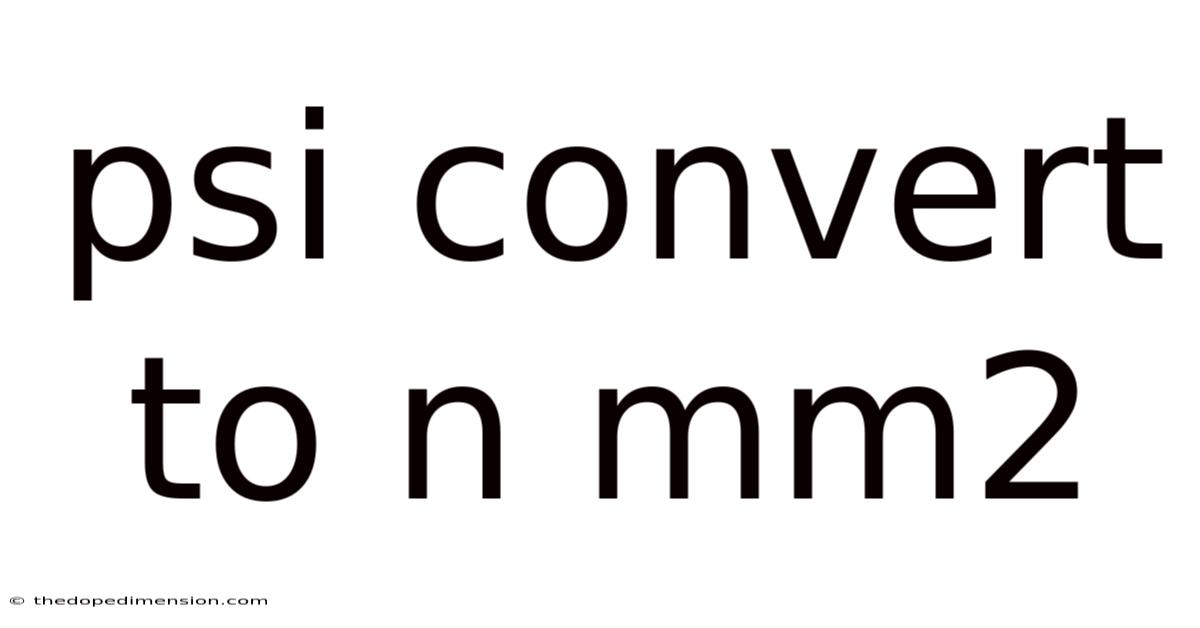Psi Convert To N Mm2
thedopedimension
Aug 25, 2025 · 5 min read

Table of Contents
Converting PSI to N/mm²: A Comprehensive Guide
Understanding pressure units and their conversions is crucial in various fields, from engineering and manufacturing to meteorology and healthcare. This comprehensive guide will delve into the conversion process from pounds per square inch (psi) to Newtons per square millimeter (N/mm²), explaining the underlying principles and providing practical examples. We'll explore the different conversion factors, address common misconceptions, and answer frequently asked questions. Mastering this conversion will enhance your understanding of pressure measurements and enable you to confidently work with diverse engineering specifications.
Understanding the Units
Before diving into the conversion, let's understand the units involved.
-
PSI (pounds per square inch): This is a unit of pressure in the imperial system. It represents the force (in pounds) exerted on a surface area of one square inch.
-
N/mm² (Newtons per square millimeter): This is a unit of pressure in the metric system (SI). It represents the force (in Newtons) exerted on a surface area of one square millimeter. It's also often expressed as MPa (Megapascals), where 1 MPa = 1 N/mm².
The Conversion Process: From PSI to N/mm²
The conversion from psi to N/mm² involves several steps, requiring the use of conversion factors for both force (pounds to Newtons) and area (square inches to square millimeters).
1. Conversion of Pounds to Newtons:
One pound (lb) is approximately equal to 4.44822 Newtons (N). This is a crucial conversion factor.
2. Conversion of Square Inches to Square Millimeters:
One inch is equal to 25.4 millimeters (mm). Therefore, one square inch (in²) is equal to (25.4 mm)² = 645.16 square millimeters (mm²).
3. Combining the Conversion Factors:
To convert psi to N/mm², we combine the conversion factors for force and area. The formula is:
N/mm² = psi * (4.44822 N/lb) / (645.16 mm²/in²)
This simplifies to:
N/mm² ≈ psi * 0.0069
This means that for every 1 psi, there are approximately 0.0069 N/mm².
Step-by-Step Conversion Example
Let's illustrate the conversion process with an example. Suppose we have a pressure of 100 psi. To convert this to N/mm², we follow these steps:
-
Identify the initial pressure: 100 psi
-
Apply the conversion factor: 100 psi * 0.0069 N/mm²/psi
-
Calculate the result: 0.69 N/mm²
Therefore, 100 psi is approximately equal to 0.69 N/mm² or 0.69 MPa.
Practical Applications and Considerations
The conversion from psi to N/mm² is vital in various engineering applications:
-
Material Strength: Engineers use this conversion to determine if a material can withstand a specific pressure. Many material specifications list their yield strength and ultimate tensile strength in N/mm².
-
Hydraulic Systems: Hydraulic systems often operate under high pressures, and understanding the pressure in both psi and N/mm² is crucial for system design and maintenance.
-
Pneumatic Systems: Similar to hydraulic systems, pneumatic systems utilize compressed air, and pressure conversions are necessary for accurate system operation and safety.
-
Tire Pressure: While tire pressure is often expressed in psi, knowing the equivalent in N/mm² can be useful for comparison with international standards and for understanding the stress on the tire material.
Advanced Considerations and Precision
While the simplified conversion factor of 0.0069 provides a reasonable approximation, for highly precise calculations, it's recommended to use the full conversion factors:
N/mm² = psi * (4.44822 N/lb) / (645.16 mm²/in²)
This ensures greater accuracy, especially when dealing with high-pressure applications where small differences can have significant implications. Remember to use appropriate significant figures in your calculations based on the precision of your input data.
Frequently Asked Questions (FAQ)
Q1: Can I use an online converter for psi to N/mm²?
A1: Yes, many online converters are available. However, understanding the underlying conversion process is essential to ensure you're using the correct tool and interpreting the results accurately.
Q2: What is the difference between MPa and N/mm²?
A2: They are essentially the same unit. 1 MPa (Megapascal) is equal to 1 N/mm². MPa is simply a more convenient unit for expressing large pressures.
Q3: Are there other units of pressure I should be aware of?
A3: Yes, several other pressure units exist, including:
- Pascals (Pa): The SI unit of pressure. 1 Pa = 1 N/m²
- Bars (bar): Often used in meteorology and fluid mechanics. 1 bar = 100,000 Pa
- Atmospheres (atm): Based on standard atmospheric pressure at sea level.
Q4: Why is accurate conversion important in engineering?
A4: Inaccurate conversions can lead to significant errors in design, manufacturing, and operation, potentially resulting in safety hazards, equipment failure, and costly rework. Precision is paramount in engineering applications.
Q5: What happens if I use an inaccurate conversion factor?
A5: Using an inaccurate conversion factor will lead to an incorrect pressure value. This can result in miscalculations that affect the design, performance, and safety of systems or structures.
Conclusion
Converting psi to N/mm² is a fundamental skill for anyone working with pressure measurements in engineering and related fields. By understanding the conversion process, the conversion factors, and the importance of precision, you can confidently handle pressure calculations, ensuring accurate and reliable results. Remember to always double-check your work and utilize the appropriate number of significant figures for the highest level of accuracy. Mastering this conversion not only improves your problem-solving abilities but also enhances your understanding of fundamental engineering principles.
Latest Posts
Latest Posts
-
0 39 Acres To Square Feet
Aug 25, 2025
-
Square Inches To Gallons Conversion
Aug 25, 2025
-
Cubic Foot To Board Foot
Aug 25, 2025
-
Mega Electron Volts To Joules
Aug 25, 2025
-
British Gallon Vs Us Gallon
Aug 25, 2025
Related Post
Thank you for visiting our website which covers about Psi Convert To N Mm2 . We hope the information provided has been useful to you. Feel free to contact us if you have any questions or need further assistance. See you next time and don't miss to bookmark.